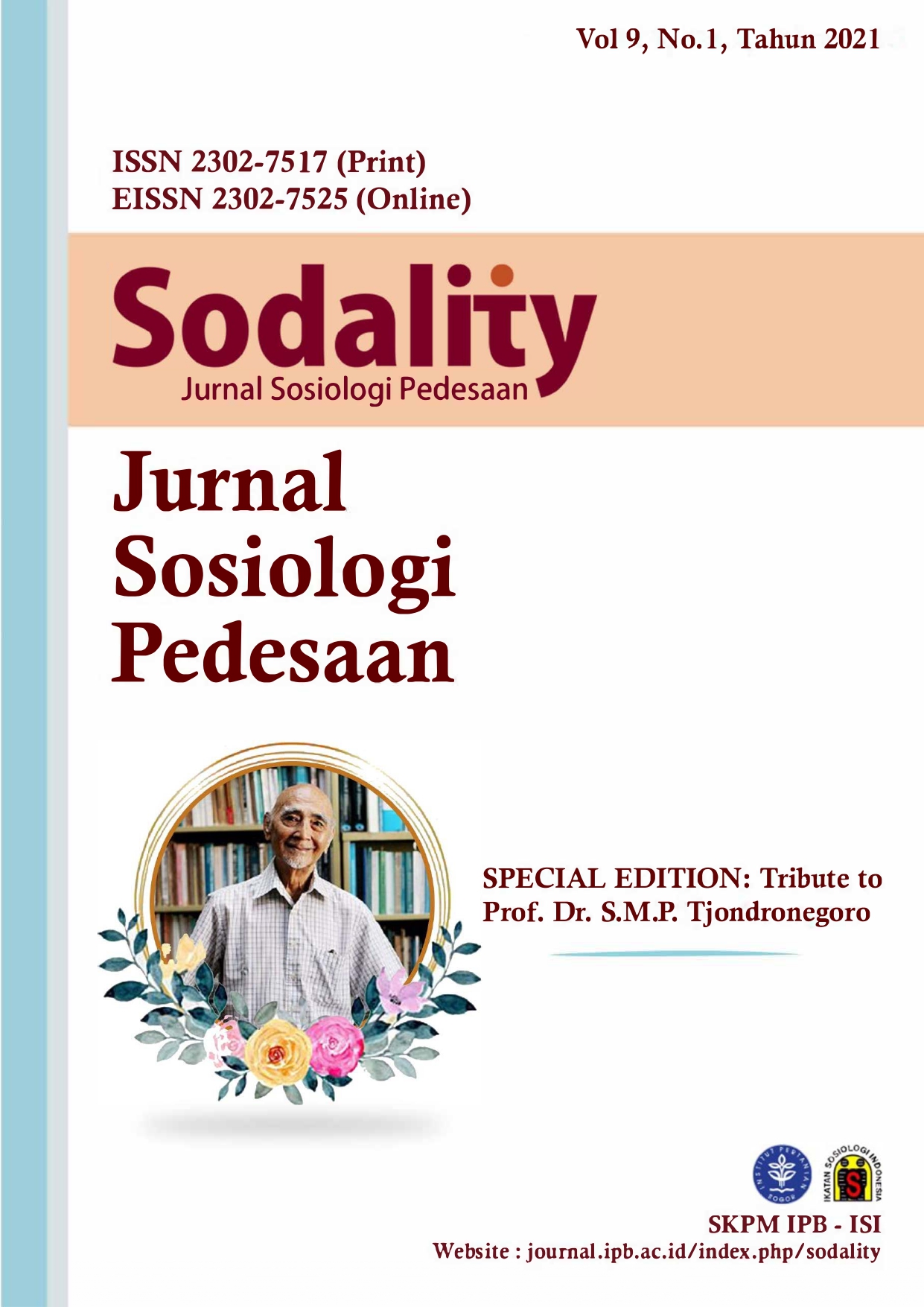Sodality in Peri-Urban Community Empowerment: Perspective of Development Communication and Extension Science
Abstract
Tjondronegoro's concept of sodality is gaining momentum to be applied in a broader context. Sodality is relevant to participatory approaches in community development, extension/empowerment, and development communication. This study aims to answer how the role of sodality is in the empowerment of peri-urban communities from communication and extension development sciences. This research method uses a participatory action study by placing the researcher to live with the community. Sodality can be interpreted as the life force of a unique community unit. However, without any family relationship, they are bound by a synergy of interest relations without eliminating the primary relationship. In the context of empowerment, the bonds in sodality are colored more with interest in achieving life necessities among community members. Thus, in peri-urban communities, sodality is closer to the meaning of social capital, which effectively strengthens the community's efforts to live a life together, both with internal and external parties. The Tjondronegoro version of the concept of sodality in the current era is not only for the smallest community unit in the community territory, but it can be strengthened by the meaning of a synergy of interests in meeting the needs of a community.
References
Chambers, R. (2007). Participation and poverty. Development, 50(2). https://doi.org/10.1057/palgrave.development.1100382
Coleman, J.S. 1999. Social Capital in the Creation of Human Capital. Cambridge Mass: Harvad. University Press. Cox, E. 1995. A Truly Civil Society. ABC Books. Sidney.
Creswell, J. W. (2003). Research design Qualitative quantitative and mixed methods approaches. Research Design Qualitative Quantitative and Mixed Methods Approaches. https://doi.org/10.3109/08941939.2012.723954
Denzin, Norman, K., & Lincoln, Yvonna, S. (2018). Introduction: The Discipline and Practice of Qualitative Research. In The Sage Handbook of Qualitative Research.
Denzin, N. K., & Lincoln, Y. S. (2000). The handbook of qualitative research / Norman K. Denzin, Yvonna S. Lincoln editors. In Qualitative research.
Freire, P. (2003). Pendidikan Kaum Tertindas, terj. Lembaga Penelitian Pendidikan dan Penerangan Ekonomi dan Sosial (LP3ES), Bandung: LP3ES
Friendman, J. (1992). Empowerment: The Politics of Alternative Development. Cambridge: Balckwell Publishers.
Fukuyama, F. (2000). Social Capital and Civil Society. International Monetary Fund Working Paper, WP/00/74,1-8.
Goulet, Denis (1997), Development Ethics: a New Discipline, Social Economics, Vol. 24, No. 11
Hayward, C. R. (1998). De-facing power. Polity, 31(1). https://doi.org/10.2307/3235365
Hentihu, I., Sumardjo, ., Sugihen, B. G., & Susanto, D. (2020). The Potential for Creative Socio-cultural Energy of Coastal Communities in the Maluku Islands. Asian Research Journal of Arts & Social Sciences. https://doi.org/10.9734/arjass/2020/v11i330173
[KEMENDESA] Kementerian Desa, Pembangunan Daerah Tertinggal dan Transmigrasi, 2019. Indeks Desa Membangun 2019 [internet]. [diunduh 2020 Februari 28]. Tersedia pada: http://idm.kemendesa.go.id/
[KEMENDESA] Kementerian Desa, Pembangunan Daerah Tertinggal dan Transmigrasi, 2016. Indeks Desa Membangun 2015. Jakarta (ID): Kemendesa.
Luitel, Y. R. (2017). Participatory Research and Empowerment: A Conceptual Revisit of the Debate on Alternative Social Science Research. Dhaulagiri Journal of Sociology and Anthropology, 11. https://doi.org/10.3126/dsaj.v11i0.18825
Mutmainah R, Sumardjo. (2014). Peran Kepemimpinan Kelompok Tani dan Efektivitas Pemberdayaan Petani. Sodality: Jurnal Sosiologi Pedesaan [internet]. [diunduh 2020 Februari 16]; 2 (3): 182-199: Bogor (ID). Tersedia pada: https://journal.ipb.ac.id/index.php/sodality/article/view/9425/7388.
Oroh A, Kumurur VA, Warouw F. (2019). Analisis Karakteristik Wilayah Peri Urban Berdasarkan Aspek Fisik Di Kecamatan Pineleng Kabupaten Minahasa. Jurnal Spasial Vol 6. No. 2.
Pettit, J., & McGee, R. (2019). Introduction: power, empowerment and social change. In Power, Empowerment and Social Change. https://doi.org/10.4324/9781351272322-1
Putnam, R. D. (1995). Bowling alone: America’s declining social capital. Journal of Democracy, 6(1), 65–78. http://doi.org/10.1353/jod.1995.0002
Reason, P. and H. Bradbury (Eds.), Handbook of Action Research: Participative Inquiry and Practice, London: Sage Publications, 2002.
Sajogyo. (1982). Modernization without Development. The Journal of Social Studies.
Servaes J. (2020). Handbook of Communication for Development and Social Change. Springer. Singapore.
Sulistiani I, Sumardjo, Purnaningsih N. (2018). Model and Communication Strategy Development in Developing Social Energy for Papua Community Empowerment. Medwell Journals: The Social Science. 13 (4): 934-942.
Sumardjo, S., Firmansyah, A., & Dharmawan, L. (2020). The Role of Creative Social Energy in Strengthening Ecological Adaptation Capacity Through Community Empowerment. Jurnal Penyuluhan, 16(2), 323–332. https://doi.org/10.25015/16202028361
Sumardjo, A. Firmansyah, L. Dharmawan, Y. P Wulandari. (2014). Implementasi CSR Melalui Program Pengembangan Masyarakat: Inovasi Pemberdayaan Masyarakat PT. Pertamina EP Asset 3 Subang Field. CARE LPPM IPB. Bogor.
Sumardjo. (2010). Penyuluhan menuju pengembangan kapital manusia dan kapital sosial dalam mewujudkan kesejahteraan masyarakat. Orasi Ilmiah Guru Besar Tetap Fakultas Ekologi Manusia, IPB Bogor 18 September 2010.
Supriyatin, R., Pravitasari, A. E., & Pribadi, D. O. (2020). Pemetaan Karakteristik Wilayah Urban Dan Rural Di Wilayah Bandung Raya Dengan Metode Spatial Clustering. Jurnal Geografi, 12(02). https://doi.org/10.24114/jg.v12i02.17647
Tjondronegoro, Sediono M.P. (1984). Social Organization and Planned Development in Rutal Java. Oxford University Press, Singapore.
Uphoff N. (1986). Local institutional development: An analytical sourcebook with cases Norman Uphoff for the Rural Development Committee, Cornell University Kumarian Press W. Hartford, Connecticut, 1986, 421 pp.
Wahyuni, S., Sumardjo, S., Lubis, D. P., & Sadono, D. (2017). Hubungan Jaringan Komunikasi dan Dinamika Kelompok dengan Kapasitas Petani dalam Agribisnis Padi Organik di Jawa Barat. Jurnal Penyuluhan, 13(1), 110-120. https://doi.org/10.25015/penyuluhan.v13i1.15115
Authors who publish with this journal agree to the following terms:
- Authors retain copyright and grant the journal right of first publication with the work simultaneously licensed under a

This work is licensed under a Creative Commons Attribution 4.0 International License. that allows others to share the work with an acknowledgement of the work's authorship and initial publication in this journal. - Authors are able to enter into separate, additional contractual arrangements for the non-exclusive distribution of the journal's published version of the work (e.g., post it to an institutional repository or publish it in a book), with an acknowledgement of its initial publication in this journal.
- Authors are permitted and encouraged to post their work online (e.g., in institutional repositories or on their website) prior to and during the submission process, as it can lead to productive exchanges, as well as earlier and greater citation of published work (See The Effect of Open Access).





.png)









